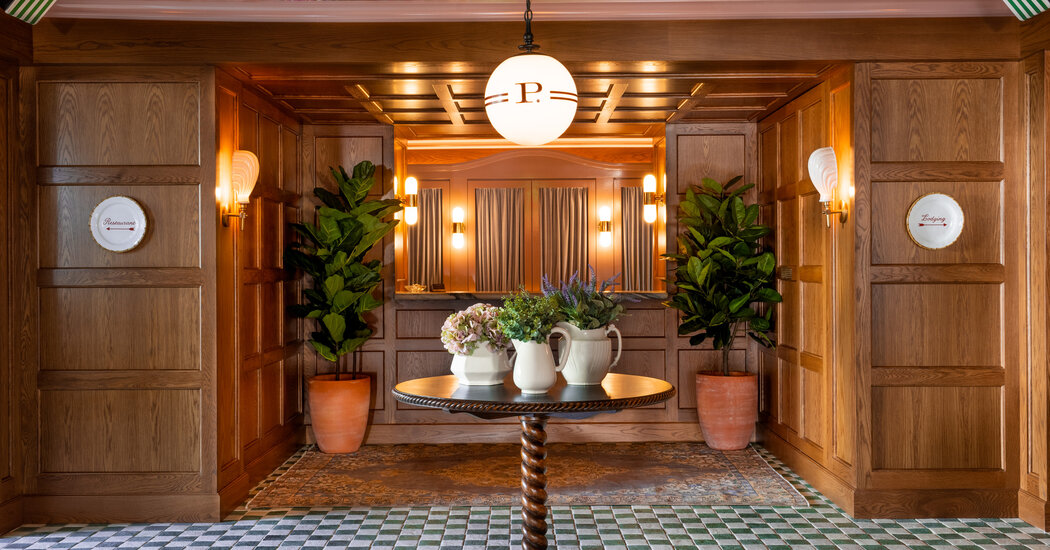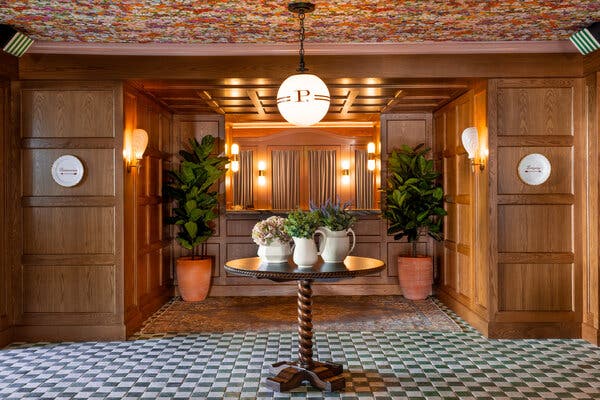
Visit This
A New Boutique Retreat in West Hollywood

The front desk at Palihouse West Hollywood.Credit…Jakob Layman, courtesy of Palisociety
By Sara Tardiff
“We didn’t want to craft a space that takes itself too seriously,” says the Palisociety founder Avi Brosh of his approach to the brand’s newest property, Palihouse West Hollywood. He sought to soften the West Third Street building’s stark exterior with an eclectic, layered interior, taking cues from playful California luxury and the unpredictable charm of a stylish European inn. There is a theatrical feel throughout, starting with the check-in desk, which was designed to look like a stage with its curtains drawn. Each of the 95 rooms is adorned with antique pieces, custom light fixtures and artwork in abundance. And while there’s plenty to see and eat nearby — LACMA, La Brea Tar Pits and Caviar Kaspia are all a short drive — the hotel offers its own ecosystem of entertainment. All-day California fare is served in the lobby lounge, cafe and bar; the Pool Lounge offers complimentary refreshments like lemonade and candy; and on the mezzanine floor, you’ll find a sake bar with Japanese-fusion small plates like pressed sushi and a chicken katsu sandwich — with an accompanying late-night takeout window. Palihouse West Hollywood opens Dec. 1, rooms from $295, palisociety.com.
Covet This
Minjae Kim’s Sculptural, Symbolic Furniture, on View in Miami
By Gisela Williams
The Miami-based gallerist Nina Johnson first became acquainted with the multidisciplinary designer Minjae Kim last summer when she saw his work at Marta, a gallery in Los Angeles. She immediately acquired a sculptural floor lamp built of highly lacquered dark Douglas fir with a fiberglass shade. And when she decided to add a library space to her gallery complex in Little Haiti, all designed by Charlap Hyman & Herrero, she knew she wanted to commission Kim to create furniture for it. “I wanted to show an artist whose work would engage with the architecture,” she explains. The New York-based Kim was born in Seoul and his work is often inspired by his multicultural identity; his wood and fiberglass chairs, tables, lamps and cabinets are typically crafted using Korean techniques and are often loaded with references both personal and historic. “The chair that I make can have more meaning than just a place to sit,” Kim says. “I try to hide the fact that the objects I make have a function.” For the opening of Johnson’s library, the 33-year-old designer created an exhibition of unique pieces under the name “IYKYK” — if you know, you know. To Kim it means that “someone with a Korean background will see another layer.” He was inspired by ancient Asian objects that he’s been researching for years, such as a traditional ceremonial chair and a light in the shape of a moon jar. “Being multicultural sometimes means you enter a realm of endless confusion,” says Kim. “But then it does make things that much more interesting.” “Minjae Kim: IYKYK” is on view from Nov. 28 to Jan. 7, 2023, ninajohnson.com.
Buy This
Italian Splatterware That’s Meant for Everyday Use
By Alice Newell-Hanson
At her Italian home in Cortona, a medieval hilltop town in Tuscany, Jennifer Perez Crisanti keeps a large green-flecked terra-cotta bowl in her kitchen sink. The Canadian-born founder of Ivo Angel, an online store selling handmade Italian splatterware, uses it for doing the dishes. Like all good design, splatterware pottery, characterized by its rapidly applied splotches of colorful glaze, is not only beautiful but functional: It’s durable, affordable and easily produced. Popularized by England’s Staffordshire potteries in the 18th century, the craft has long been practiced in Italy, and Perez Crisanti collaborates with a local master artisan, Giulio Lucarini, to make Ivo Angel’s pieces, which range from generously proportioned mixing bowls and sturdy water jugs to a ruffle-edged fruit stand. While working in his studio, Lucarini likes to tell stories about life in Cortona (“some of them are quite scandalous,” Perez Crisanti says), where his family has been based for generations. She hopes the pieces, which are intended for everyday use, will become similarly entwined with their owners’ lives. “It’s important to surround ourselves,” she says, “with things that have a soul.” From $20, ivoangel.com.
Wear This
An Elegant Cross-Continent Fashion Collaboration
By Becky Malinsky
The Italian designer Marco Zanini launched his women’s fashion brand Zanini in 2019 to an instantly devoted audience. Prepandemic, his collections were shown during biannual fashion weeks in his treasure-filled Milanese apartment turned salon for clients and buyers who felt like he’d created his precise tailoring and feminine layers just for them. It was this intimacy that made it impossible to keep the small, self-funded brand afloat as Covid restrictions continued on two years later. But during the long days at home, the designer kept in touch with the friends he’d made while producing his line. It was one of these chats with Sonya Park, the founder of the Japanese retail destination Arts & Science, that ignited his most recent project. Park suggested he send his fabrics and patterns to Japan, where she would produce a capsule collection. So started a back-and-forth design project where signature Arts & Science shapes and styles were rendered in the Italian designer’s fabrics — and vice versa — like a Zanini suit cut in a Japanese-woven salt-and-pepper cashmere and a boxy, classic Arts & Science blouse made from a Zanini wool-and-silk checkerboard fabric. “We were like kids playing together in a sandbox,” Park says of the partnership. Zanini is giddy with excitement about the experiment, considering it a “genius” way for him and other small designers to stay connected to their work. “Sonya was an inspiration for me when I launched my business, so this is really a dream come true,” he says. The collection is meant to be the kickoff of a continued collaboration, officially calledZanini with Arts & Science, now available at Arts & Science stores.
Eat This
A Restaurant From the Architects of the Yves Saint Laurent Museum in Marrakesh
By Gisela Williams
Not only did the architects Karl Fournier and Olivier Marty design the celebrated Yves Saint Laurent museum in Marrakesh but, almost 20 years ago, the duo behind Studio KO also helped restore the city’s legendary restaurant and meeting place, Grand Café de la Poste. They spent three years transforming the building for the French restaurateur couple Pierre Pirajean and Helena Paraboschi. This month, the same team has come together again to open Sahbi Sahbi, a jewel box of a restaurant in the neighborhood of Gueliz. Inspired by traditional family recipes and built around the concept of a nonhierarchical, women-led kitchen team, Sahbi Sahbi serves Moroccan dishes like cumin-spiked lamb and tagine with chermoula-marinated sea bass. Fournier says that, like the food, the idea behind the design was “to pay tribute to Moroccan crafts.” A variety of textured surfaces — a wall of triangular tiles and carved ceilings — made of natural materials such as brick and cedar surround a central open kitchen, which is meant to act as a stage for the women who run it. “It’s brave and difficult for women in Morocco to work in a place that serves alcohol,” explains Paraboschi. “They have to get several authorizations just to be allowed to be employed here. I have wanted for many years to create an authentic Moroccan restaurant that honored and gave opportunity to women.” The concept appealed so much to the two architects that they asked to be partners in the business, making it their first project as restaurateurs. That’s why it’s called Sahbi Sahbi, which means “soul mates” in Moroccan Arabic. sahbisahbi.com
See This
New York’s Native Art Market, in Person Again
By Kelly Boutsalis
Ahead of the holidays, the National Museum of the American Indian is hosting its 15th annual Native Art Market showcasing artists selected by a committee of curators and cultural specialists. In the Diker Pavilion, located within the grand columned museum at the southern tip of Manhattan, the Tuscarora beadwork artist Grant Jonathan will display his ornaments and the Navajo artist Melvin Platero will bring the contemporary gold and silver jewelry he creates using traditional tufa casting techniques. The group of 39 featured artists also includes the trailblazing designer Dorothy Grant, who pairs traditional Haida art with fashion design, and the renowned Diné inlay jewelry artist Jimmie Harrison. This year marks the annual market’s return to an in-person event after a two-year hiatus because of Covid restrictions. (The museum’s Washington, D.C., counterpart will hold its Native Art Market at the same time, with a different roster of artists.) The museum’s head of public programs, Shawn Termin (Lakota), is thrilled that this will mean more interactions between collectors and artists. “Through the close one-on-one conversations that take place between art market visitors and the artists, people can develop a deeper understanding of Native art and cultures,” she says. Museum members get first pick at a preview reception held on Dec. 2. The National Museum of the American Indian’s Native Art Market is on view Dec. 3 and Dec. 4, americanindian.si.edu.
From T’s Instagram
Holiday Table Settings From Our Archive